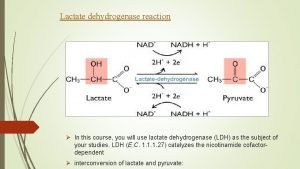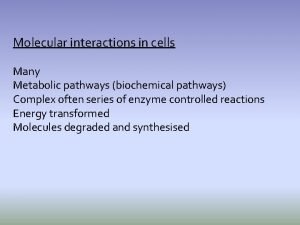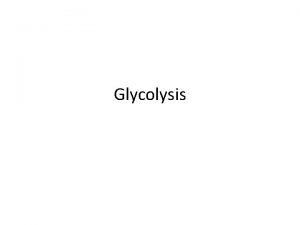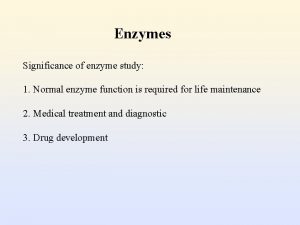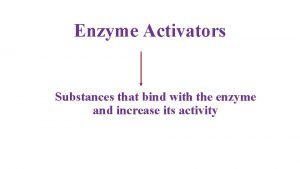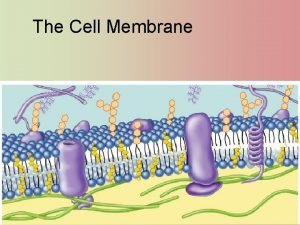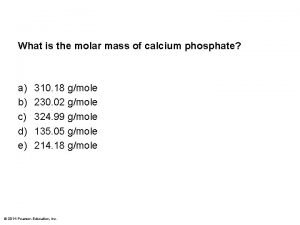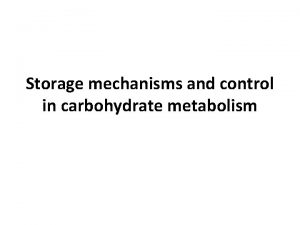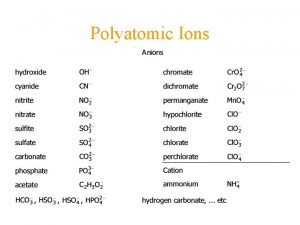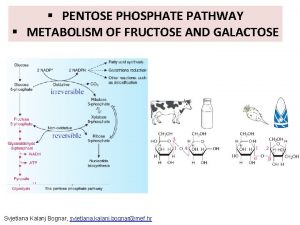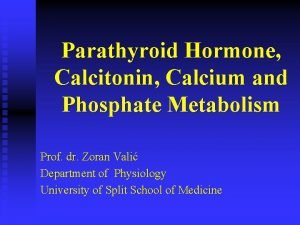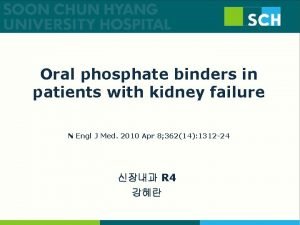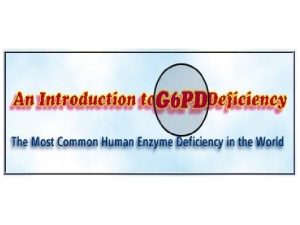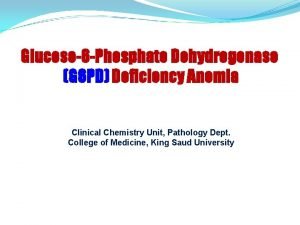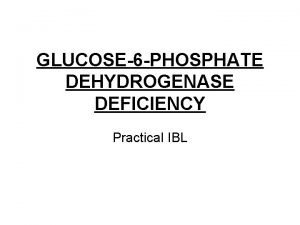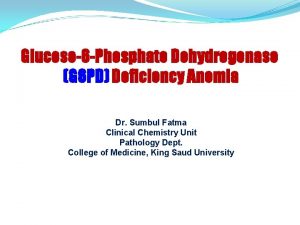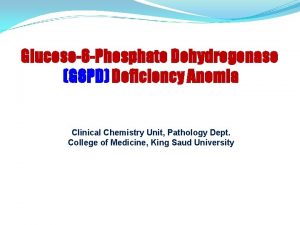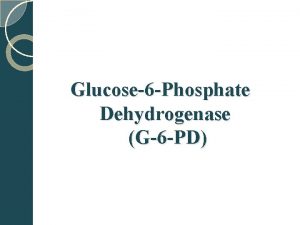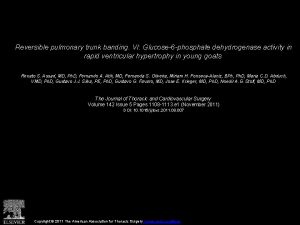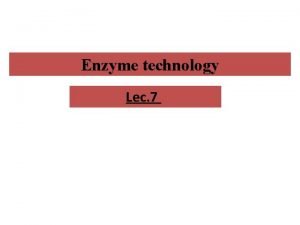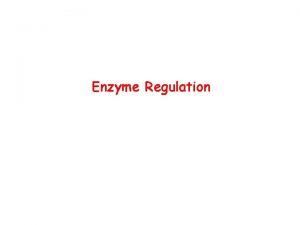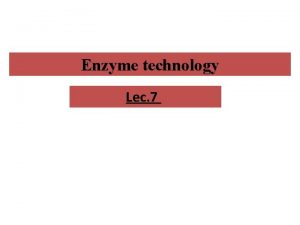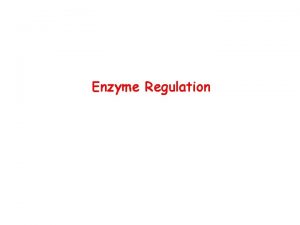overviw Red cell enzyme Glucose6 phosphate dehydrogenase deficiency















- Slides: 15

overviw • Red cell enzyme • Glucose-6 -phosphate dehydrogenase deficiency • Causes: • Symptoms • Laboratory diagnosis • How do you treat It • Risks

Red Cell Enzyme • Glucose-6 -phosphate dehydrogenase (G 6 PD) is a type of protein, called an enzyme, that helps red blood cells work properly

Anaerobic glycolysis Glucose-6 -P G 6 PD Aerobic metabolism Detoxification of metabolites of oxidative stress Elimination of methemoglobin • F--6 --P

Glucose-6 -phosphate dehydrogenase deficiency • Glucose-6 -phosphate dehydrogenase (G-6 PD) deficiency is a hereditary condition in which red blood cells break down when the body is exposed to certain drugs or the stress of infection • Too little G 6 PD leads to the destruction of red blood cells. This process is called hemolysis. When this process is actively occurring, it is called a hemolytic episode

Glucose-6 -phosphate dehydrogenase deficiency • Low G 6 PD activity results in low levels of NADPH and reduced glutathione, which are required to protect hemoglobin from oxidative damage

In the absence of adequate reducing ability (provided by G 6 PD), oxidizing agents convert hemoglobin to methemoglobin , then denature it, causing it to precipitate as Heinz bodies methemoglobin,

• Alternative Names: • G-6 -PD deficiency; Hemolytic anemia due to G 6 PD deficiency

• Causes: • Red blood cell destruction can be triggered by infections, severe stress, certain foods (such as fava beans), and certain drugs, including: • Antimalarial drugs • Aspirin • Nitrofurantoin • Quinidine • Quinine • Sulfa drugs

• In the United States, G 6 PD deficiency is more common among blacks than whites. Men are more likely to have this disorder than women. • You are more likely to develop this condition if you: • Are African American • Are of Middle Eastern decent, particularly Kurdish or Sephardic Jewish • Are male • Have a family history of the deficiency

• You are more likely to develop this condition if you: • Are African American • Are of Middle Eastern decent, particularly Kurdish or Sephardic Jewish • Are male • Have a family history of the deficiency

Symptoms • Persons with this condition do not display any signs of the disease until their red blood cells are exposed to certain chemicals in food or medicine, or to stress. • Symptoms are more common in men and may include: • Dark urine • Enlarged spleen • Fatigue • Pallor • Rapid heart rate • Shortness of breath • Yellow skin color (jaundice

Laboratory diagnosis • • • CBC retic profile urinalysis LDH/haptoglobin fractionated bilirubin blood smear with stains for Heinz bodies G 6 PD fluroescent spot test o Detects deficient production of NADPH from NADP. In this test NADPH is fluorescent and its absence (due to G 6 PD deficiency) results in lack of fluorescence. • G 6 PD spectrophotometry to detect level of activity • genetic test for variants

How do you treat it? • • • avoid offending medications supportive care hydration to protect against renal failure transfusions, folic acid splenectomy and vitamin E (anti-oxidant) have been suggested but not been proven effective • • ***because hemolysis is usually mild, drugs may be given if there is important indication

Risks • Veins and arteries vary in size from one patient to another and from one side of the body to the other. Obtaining a blood sample from some people may be more difficult than from others. • Other risks associated with having blood drawn are slight but may include: • Excessive bleeding • Fainting or feeling light-headed • Hematoma (blood accumulating under the skin) • Infection (a slight risk any time the skin is broken)

References • www. med. unc. edu • www. cumc. columbia. edu • www. nlm. nih. gov
 Lactate dehydrogenase
Lactate dehydrogenase Succinate dehydrogenase inhibitor malonate
Succinate dehydrogenase inhibitor malonate Amp glycolysis
Amp glycolysis Succinate dehydrogenase inhibitor malonate
Succinate dehydrogenase inhibitor malonate Succinate dehydrogenase inhibitor malonate
Succinate dehydrogenase inhibitor malonate Activators for enzymes
Activators for enzymes Pyruvate to acetyl coa
Pyruvate to acetyl coa Pyruvate dehydrogenase mechanism
Pyruvate dehydrogenase mechanism Cell membrane phosphate head
Cell membrane phosphate head Fill in the blanks
Fill in the blanks Calcium phosphate molar mass
Calcium phosphate molar mass Gluconeogenesis meaning
Gluconeogenesis meaning Ate vs ite
Ate vs ite Pentose phosphate pathway
Pentose phosphate pathway Bone fluid
Bone fluid Phosphate binders
Phosphate binders
